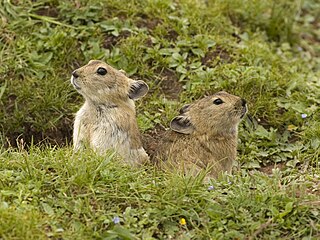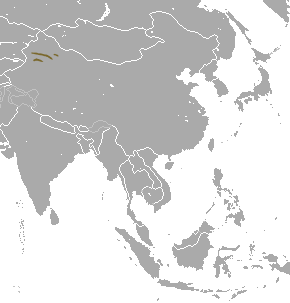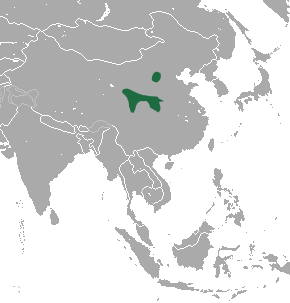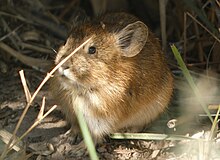
The northern pika is a species of pika found across mountainous regions of northern Asia, from the Ural Mountains to northern Japan and south through Mongolia, Manchuria and northern Korea. An adult northern pika has a body length of 12.5–18.5 centimeters (4.9–7.3 in), and a tail of 0.5–1.2 centimeters (0.20–0.47 in). The pika sheds its fur twice annually, bearing a reddish-brown coat in the summer and grayish-brown coat in winter. It feeds on various plant material and makes "hay piles" for winter use.

The Gansu pika or gray pika is a species of mammal in the pika family, Ochotonidae. It is endemic to China.

The plateau pika, also known as the black-lipped pika, is a species of mammal in the pika family, Ochotonidae.

The Daurian pika is a small relative of rabbits and hares in the order Lagomorpha. It is well known for its “barking” alarm call, and for its peculiar habit of making hay to help survive the winter. There are 4 recognized subspecies, Ochotona dauurica annectens, O.d. bedfordi, O.d. dauurica, and O.d. mursavi. Daurian pikas, like other lagomorphs, are characterized by a secondary set of incisor teeth. They are sexually monomorphic, with thick reddish coats. Pikas have no external tail, and their ears are large and rounded. The auditory bullae, a feature of the skull of daurian pikas are small in comparison to many other pikas. This is thought to be related to their fairly low altitude habitat preference. They are considered keystone species within their habitat.

The Chinese red pika is a species of mammal in the family Ochotonidae. Typical of a pika it has short limbs, a small tail and round ears. Specific to the Chinese red pika has distinctive red color in its pelt. The Chinese pika typically lives in rocky terrain at altitudes between 600 and 1200 meters. and is endemic to the East Qinghai, West Gansu and Northern Sichuan provinces of China and Eastern Tibet.

Forrest's pika is a species of mammal in the pika family, Ochotonidae. It is found in Bhutan, China, India, and Myanmar. The summer dorsal pelage and ventral pelage are dark rufous or blackish brown, and the winter dorsal pelage is a grayish brown, slightly lighter in tone than the ventral pelage. It is a generalist herbivore. It was assessed by the IUCN Red List of Endangered Species as insufficiently known in 1994, as near threatened in 1996, and re-assessed in 2008 as a species of least concern.

Glover's pika is a species of mammal in the family Ochotonidae. It was first described in 1922, by Michael Rogers Oldfield Thomas. The summer dorsal pelage is grayish rufous, grayish brown, or tea brown in colour. The winter pelage is similar to the summer pelage, but is lighter in tone. Endemic to China, it is found in high altitudes of northeastern Tibet, southwestern Qinghai, western Sichuan, and northwestern Yunnan. It is a generalist herbivore, and is known to construct haypiles. It is rated as a species of least concern by the International Union for Conservation of Nature. It is also regionally red listed as least concern in China.

Hoffmann's pika is a species of mammal in the pika family, Ochotonidae, that is endemic to Mongolia. It is currently listed as endangered by the International Union for Conservation of Nature (IUCN).

The Ili pika is a species of mammal in the family Ochotonidae, endemic to northwest China. After its discovery in 1983, it was studied for a decade. Increased temperatures, likely from global warming, and increased grazing pressure may have caused the rapid decline in population. According to IUCN last assessed in 2018, the Ili pika is now considered an endangered species, with approximately fewer than 1,000 left.

The Ladak pika, also known as the Ladakh pika, is a species of mammal in the family Ochotonidae found in China, India, and Pakistan. Prior to identification as a separate species, specimens were thought to be of the plateau pika. Named for the Ladakh region, they are commonly found in valleys of the mountain ranges spanning from Pakistan through India to China at an elevation between 4,300 and 5,450 m and are herbivores.

The large-eared pika is a species of small mammal in the family Ochotonidae. It is found in mountainous regions of Afghanistan, Tibet, Bhutan, India, Kazakhstan, Kyrgyzstan, Nepal, Pakistan and Tajikistan where it nests among boulders and scree.

Royle's pika, also called the Himalayan mouse hare or hui shutu, is a species of pika. It is found in Bhutan, China, India, Nepal, and Pakistan.

The Afghan pika is a species of small mammal in the pika family, Ochotonidae. It is found in Afghanistan, Iran, Pakistan and Turkmenistan and the IUCN lists it as being of "least concern".

The Turkestani red pika is a species of mammal in the family Ochotonidae. The summer fur at its back is bright rufous and the ventral fur is white or ochraceous. The winter dorsal fur is pale brown and the ventral fur is white or light ochraceous in colour. It is found in the mountains of western Xinjiang in China, and sporadically also in the central Asian mountains in Kazakhstan, Kyrgyzstan, Tajikistan, and Uzbekistan. The female has a low fertility rate, and gives birth to offspring during the breeding season from spring to summer. She generally produces two litters each year, with two to six young. It is rated as a species of least concern on the International Union for Conservation of Nature Red List of Endangered Species, but it is considered to be near-threatened within the China part of its range.

The Moupin pika, also known as Ribetischer Pika, Moupin-Pika, Pika del Tibet, and Manipuri pika, is a species of mammal in the pika family, Ochotonidae. It has many subspecies, some of which may be distinct species. Its summer pelage is dark russet-brown with some light spots on the dorsal side, and ochraceous buff tinged on the belly. In winter it is lighter, with buff to dull brown dorsal pelage. A generalist herbivore, it is found in the mountains of the eastern Tibetan Plateau in China, Bhutan, India (Sikkim), and northern Myanmar. Both the International Union for Conservation of Nature Red List of Endangered Species and the Red List of China's Vertebrates classify it as a species of least concern; although one subspecies may be endangered.

Pallas's pika, also known as the Mongolian pika, is a species of small mammals in the pika family, Ochotonidae. It is found mainly in the mountains of western Mongolia.

The Tsing-ling pika is a species of pika endemic to the mountains in Central China. It inhabits mountainous forests and shrublands. It is a poorly known species.

The Turuchan pika is a species of pika found in isolated regions in the Central Siberian Plateau. It is a small (16–19 cm) rock dwelling species that is active during the day due to the low temperature at night. It was previously thought to be a subspecies of the Northern pika. Little is known about this species, but is known to be locally abundant.




















